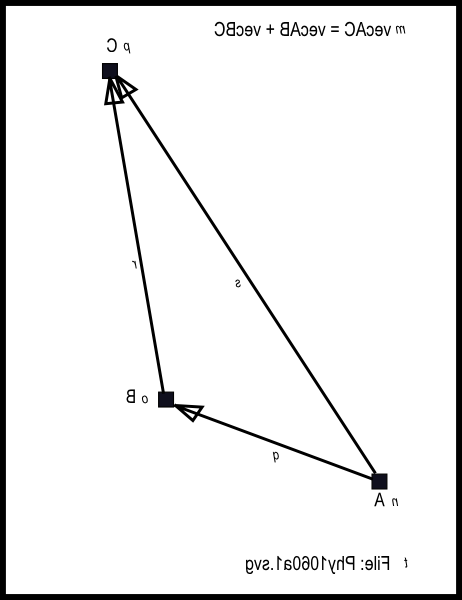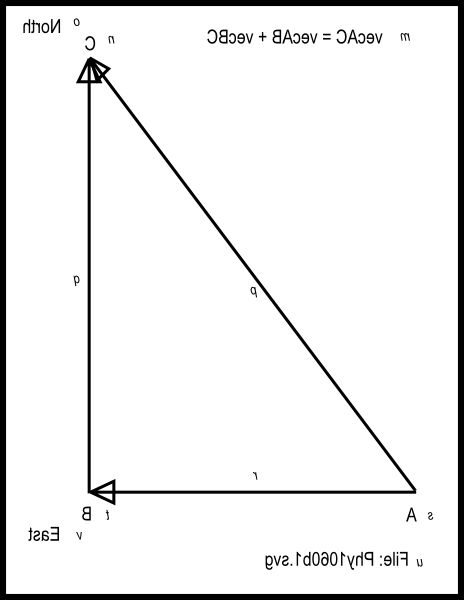| << Chapter < Page | Chapter >> Page > |
A graph board exercise
The svg file for this exercise is named Phy1060a1.svg. The table of key-value pairs for this file is provided in Figure 1 .
| Figure 1 . Key-value pairs for the image in Phy1060a1.svg. |
|---|
m: vecAC = vecAB + vecBC
n: Ao: B
p: Cq: This is vector AB
r: This is vector BCs: This is vector AC, which is the sum of the other two vectors
t: File: Phy1060a1.svg |
The image contained in this file is shown in Figure 2 . A non-mirror-image version of the file is shown in Figure 14 .
| Figure 2 . Mirror image contained in the file named Phy1060a1.svg. |
|---|
 |
Graph board instructions
Please mark three points on your graph board using pushpins and mentally label them A, B, and C. Then use rubber bands, pipe cleaners, or whatever worksbest for you to connect them in such a way that they form a triangle. That triangle is a physical representation of the vector equation
vecAC = vecAB + vecBC
What does this mean?
This vector equation does not mean that the algebraic sum of two sides of the triangle are equal to the third side. However, it does mean that the displacement vecAB togetherwith the displacement vecBC, have an effect that is equivalent to the single displacement vector vecAC.
Scalar addition and subtraction
When adding or subtracting scalars, you only need to take the magnitude values of the scalars into account and perform normal arithmetic using thosemagnitude values. An example would be to add 6 birds and 5 birds to produce a sum of 11 birds.
Vector addition and subtraction
However, when adding or subtracting vectors, you not only need to take the magnitude of the vectors into account, you also need to take the directions ofthe vectors into account.
Another graph board exercise -- a familiar example
The svg file for this exercise is named Phy1060b1.svg. The table of key-value pairs for this file is provided in Figure 3 .
| Figure 3 . Key-value pairs for the image in Phy1060b1.svg. |
|---|
m: vecAC = vecAB + vecBC
n: Co: North
p: Resultant vector A Cq: Displacement vector B C
r: Displacement vector A Bs: A
t: Bu: File: Phy1060b1.svg
v: East |
The image contained in this file is shown in Figure 4 . A non-mirror-image version of the file is shown in Figure 15 .
| Figure 4 . Mirror image contained in the file named Phy1060b1.svg. |
|---|
 |
Graph board instructions
Place a pin in the graph board and mentally designate that point as point A. Now pretend thatyou walk 30 meters due east and place a pin at that point. Mentally designate that point as point B.
Up to this point, your displacement can be represented by vecAB with a magnitude of 30 and anangle of zero (assuming that due east represents an angle of zero).
Walk 40 meters due north
Now pretend that you walk 40 meters due north, mentally designate the stopping point as C, and place a pin there. Your displacement relative to point B can berepresented as vecBC with a magnitude of 40 meters and a direction of north or 90 degrees.
Displacement relative to point A
The interesting question is, what is your displacement relative to your starting point at A?

Notification Switch
Would you like to follow the 'Accessible physics concepts for blind students' conversation and receive update notifications?